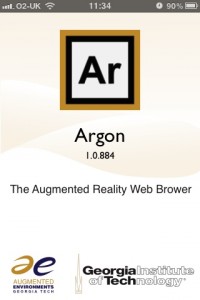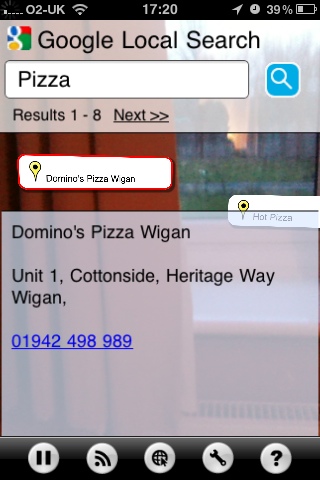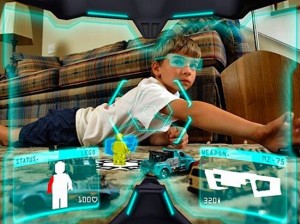Argon is a mobile Augmented Reality (AR) Browser for the iPhone. From the website:
Argon is the completely open standards augmented reality browser that allows rapid development and deployment of Web 2.0 style augmented reality content.
Argon renders a standards compliant combination of KML, HTML, CSS and JavaScript served via typical HTTP servers
Multiple simultaneous channels, analogous to browser tab on the desktop, let authors create dynamic and interactive AR content using existing web development toolsets.
The browser is stated as being the reference implementation of Georgia Tech’s work on the KHARMA Mobile AR Architecture, which combines HTML for content with KML for defining geographical co-ordinates (as used by Google Maps, Google Earth & Yahoo Maps).
One thing that seems to counter-balance this standards flag bearing though (for me, at least) is the fact that Argon is only available on iPhone – in fact, the developers go so far as to specify that it is best run on the latest version, iPhone 4. Hopefully that will change over time and we’ll see versions for the other popular mobile platforms too: the ever growing Android and the recently adrenaline-injected Windows Phone 7. After all, it would seem a little odd lauding the open standards route while then being restricted to a single delivery platform.
But there’s plenty of growing room in the still young AR space. With the technology making a significant appearance in this year’s Horizon Report – given a ‘Time-to-adoption’ period of 2-3 years, and us already seeing mobile augmented reality being implemented at Exeter Uni on their JISC LTIG Project: Unlocking the Hidden Curriculum, it’s good to see a new offering in this area to possibly compete with the current big players: Layar, Wikitude & Junaio.
My wish? My wish is that we could see something like Argon develop into a platform for AR developers, built on open standards, that would be supported by those players and open up the AR space to easily create interactive and immersive mobile AR experiences & content that you could then deploy cross-browser. Like I say though…early days yet. Hopefully we’ll see it happen.
Oh..one more thing…I have installed Argon on my (now lowly) iPhone 3GS and while the browser looks pretty standard fare – channel view, map, search, etc – unfortunately it seems there are absolutely no POIs (Points of Interest) nearby and the search for local channels isn’t yet implemented. So, as yet, it’s a bit difficult to get a handle of whether Argon would float my boat. Next up I shall go and check out the developer’s area and have a look at creating my own POIs and content. I’ll let you know how I get on…
The Argon browser can be found at http://argon.gatech.edu/
*** Update ***
There are POIs available nearby – I just hadn’t looked at the getting started tutorial properly (I know…I’m one of those blokes that doesn’t read the manual). I’m liking the search box in the realview but the POI icon itself is a bit flaky and judders about a bit too much – I suspect their recommendation of using iPhone 4 is down to the gyroscope aiding with that, which the 3GS doesn’t have. But as you can see from the screenshot, it does the basics and I would imagine one can customise the look with your own CSS. Now…let’s hope their documentation is clear and helpful and not simply written by some Tefal headed genii in a Georgia Tech Lab…


 Yes folks, by now many of you will be aware of this growing buzz around the rather snazzy and futuristic sounding ‘Augmented Reality’ (AR). The headlines are growing, the clamour is getting more excitable by the day and even though it’s only really hit the public consciousness relatively recently, I don’t think we’re far away from that glorious, early-doors hype bubble popping to the sounds of “well…there’s not many apps!”, “is it just for restaurants and tube stations?” and “it’s not a game-changer, it’s a fad!”. For that last one just look at the James Cameron’s Avatar 3D story (and nobody’s even seen it yet!)
Yes folks, by now many of you will be aware of this growing buzz around the rather snazzy and futuristic sounding ‘Augmented Reality’ (AR). The headlines are growing, the clamour is getting more excitable by the day and even though it’s only really hit the public consciousness relatively recently, I don’t think we’re far away from that glorious, early-doors hype bubble popping to the sounds of “well…there’s not many apps!”, “is it just for restaurants and tube stations?” and “it’s not a game-changer, it’s a fad!”. For that last one just look at the James Cameron’s Avatar 3D story (and nobody’s even seen it yet!)